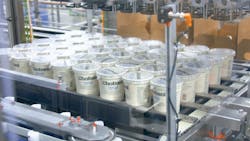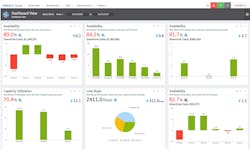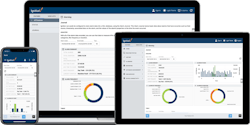Until about 10 months ago, Hugh Roddy, the vice president of global engineering and project management at Chobani, spent much of his time on the road traveling between the company’s plants in New York and Idaho, as well as periodically heading overseas to check in on the Australian factory. But his road warrior ways have been curbed by COVID-19, and now—like many of his manufacturing peers—he has to manage the projects and operations remotely.
As a result, Roddy has been turning to technology, including HMI (human machine interface) and SCADA (supervisory control and data acquisition) systems, the Industrial Internet of Things (IIoT), and augmented reality (AR) to remotely manage assets and troubleshoot machines. But he also needs visibility into how each plant is operating overall. A few years ago, that may have been a problem. But since Chobani’s adoption of Inductive Automation’s Ignition platform, which he describes as a modern day OT (operations technology) operating system, he’s been able to develop many different applications and dashboards, giving him and his team the ability to manage new projects, assist with the operations of current production lines, and gain an eagle’s eye view of individual plants from the enterprise level.
“When I log into our Ignition system I can see New York, Twin Falls (Idaho), and Australia at any given moment in time,” Roddy says. “The plants are more connected to what is happening downstream and upstream...and at the enterprise level it allows plants to be highly integrated from the plant floor to the executive level and back down.”
While Chobani adopted the Ignition platform years ago, other companies are just now starting their digital development journey—a process that has been put on fast-forward due to COVID-19. Now, every business, regardless of the industry segment, is finding new ways to stay connected.
“The pandemic is accelerating the movement to digital and smart factories to keep operations running as efficiently as possible and to share [information] across cells in a plant, lines in a plant, or plants in a network,” says Paul Wellener, a vice chairman at Deloitte LLP and the leader of the company’s U.S. Industrial Products and Construction practice.
Deloitte, together with the Manufacturer’s Alliance for Productivity and Innovation (MAPI), recently published a report called “Accelerating Smart Manufacturing: The Value of an Ecosystem Approach,” which indicates that long-term partnerships in the form of an ecosystem can accelerate digital initiatives and drive results. According to the report, while the manufacturing industry was already on a digital transformation journey, it has historically been complicated by the complexity of digitally connecting assets that, in some cases, are more than 50 years old.
The disruption and economic hardship caused by the ongoing pandemic have increased the urgency to accelerate smart manufacturing initiatives for future competitiveness. In a recent MAPI CEO poll, 85% of leaders agreed or strongly agreed that investments in smart factories will rise by June 2021. And, while economists predict that overall business investments could be low for the next three cycles, respondents in the study indicated they are directing a greater share of their factory investments toward smart manufacturing initiatives.
So, while it may have taken a global pandemic to push organizations to find new ways to work virtually, the folks living in this new normal say the real revelation here is not how technology can create a connected factory, but how people use the technology and how it can standardize processes.
“It’s not so much about digitization or IIoT devices,” Roddy says. “The transformational component is an organizational design that empowers the technology user. Connecting factories is about allowing people to see what is going on.”
Indeed, industry experts agree that people and processes are the key to the connected factory.
“Technology was never the barrier. It was always the people or the processes or the metrics in the organization that were the inhibitors or barriers to getting the benefits they were looking for,” Wellener says.
Because technology is the catalyst to connectivity, much of the work of getting plants connected in a practical fashion has to do with the data gathered and what operators do with it. And as cloud, analytics, and artificial intelligence technologies evolve, so do the way manufacturers work.
When manufacturers first think about connecting factories, a typical starting place is the manufacturing execution system (MES). That’s exactly where Procter & Gamble (P&G) went as it embarked upon its own digital transformation, finding that, of its 101 plants, 94 sites are using GE Digital's Proficy MES, while those using other, homegrown system are actively transitioning to Proficy.
P&G has more than 2,000 manufacturing lines and 45,000 operators, and according to Tim Rogers, P&G’s chief architect for manufacturing services, the company is currently trying to figure out how to deal with more than 100 plants, each of which has its own unique applications.
“They tend to be big, they are local, and people want the data, so we looked at what we could do differently,” Rogers said during a presentation at GE Digital’s user conference in October. “We have a lot of infrastructure at the facilities [and we thought] let’s get it out of the facilities. [Because] if we leave it there it will ultimately drive increased cost to maintain and support it.”
That resulted in a pilot program with GE Digital to test its Predix Manufacturing Data Cloud (MDC), as a way to move manufacturing data to the cloud and apply analytics.
According to GE Digital, Predix MDC enables the consolidation of three data sets required for process optimization and analytical applications: asset data, ERP data, and manufacturing data. In addition, the cloud structure is secure-by-design and managed 24/7. It ingests incremental data automatically without having to rely on human intervention and its edge technology includes monitoring and remote configuration.
Bringing data to the cloud resulted in an 80% reduction of onsite infrastructure at P&G, which also increased performance because there was less data for applications to wade through. “At the same time, we have so many people accessing this information and they are starting to do more advanced analytics or prognostics or predictions of what might be happening in our plants, or what we could do differently,” Rogers said. “And now that this information can be used centrally across the plants, it can be correlated with other information in the company to do more machine learning and advanced analytics as well.”
To that end, GE Digital is positioning its product portfolio around three areas: the connected worker, enterprise scale and visibility, and lean continuous improvement. “[Technologies] like MDC allow enterprise scale visibility and the ability to aggregate actionable data at new levels,” says Richard Kenedi, general manager of GE Digital’s digital plant business.
While GE Digital is working closely with customers like P&G, others—including Deloitte, Rockwell Automation, and Schneider Electric—are building their own proof-of-concept smart factories.
In September, Deloitte launched The Smart Factory @ Wichita, located at Wichita State University (WSU). Deloitte and WSU are constructing a new 60,000 square foot facility that will include a full-scale production line, dedicated space for select ecosystem sponsors, and experiential labs for exploring smart factory capabilities using AI, IoT, and robotics to manufacture products. The purpose of the facility, which will be open to the industry in 2021, is to create a dialogue about how companies can accelerate their journey toward scalable and sustainable capabilities.
Rockwell Automation embarked on its own internal digital transformation, which led to numerous lessons learned and the launch of its Connected Enterprise consulting organization. This organization includes the acquisition of Kalypso, a firm specializing in digital transformation. Based on its own experience, “we created a new and thoughtful approach, thinking not just about technology, but also about the process and first and foremost about people and the organizational dynamic,” says Bob Murphy, senior vice president of enterprise change management at Rockwell Automation. “We found [people] to be the most essential ingredient in making something happen in terms of connected factories.”
Similarly, about three years ago, Schneider Electric launched a smart factory in the U.S. in Lexington, Ky., a build-out that took place in a brownfield factory that had been around for 60 years. The goal was to create a standardized smart factory program integrated with lean manufacturing practices.
“MES was the first investment, but there’s been a couple of investments since then in different technologies,” says Luke Durcan, Schneider Electric’s EcoStruxure director. “We’ve got multiple automation solutions, robots, drives, recipe management, and we’ve also invested in novel technology around augmented reality.” The company developed AR for wearable devices that connects to a PLC or the electrical infrastructure of a machine, giving users a number of potential recourses when a failure occurs and walking them through the steps required to execute a repair.
Chobani’s Roddy is also a big fan of AR, especially since the start of the pandemic, as it has allowed the company to continue to lean on technology suppliers and machine builders for virtual support while empowering operators to solve problems. “A maintenance person with AR goggles can show someone thousands of miles away what is going. That in itself allows us to be more connected,” he says.
Collecting data to connect factories is one thing. Understanding what the data means is another. That’s where companies like TrendMiner and Sight Machine come in.
TrendMiner works with time series process and asset data coming from machine sensors that is typically stored in historians, as well as quality, maintenance, and batch records from other business applications. Typically, historians are slow to search and analyze data. But TrendMiner’s pattern recognition and search tools can access multiple years of historian data to search for patterns within a split second.
“Just like Google provides search on the web, we have indexed the data so there’s that same value proposition,” says TrendMiner product manager Rob Azevedo. “TrendMiner works like Google in the way that we provide a cache on top of all that data to make it searchable and available for analysis in seconds. And just like Google, where you have one entry point where you can launch your data search and it searches every website from there, the same happens in TrendMiner. You have our single application that caches all of your data sources and provides the tools and search capabilities to analyze all of your data, regardless of where it comes from.”
In addition, since it’s available as a cloud-based software-as-a-service, TrendMiner can access different time series sources from different factories around the world to generate insights from a central level while sharing with the people onsite, Azevedo says. “The key differentiator is that we analyze time series data, but we also bring in the contextual universe and link to that data. This allows the subject matter experts to analyze what has happened, quickly find the root cause, and monitor to avoid certain behavior in the future.”
Manufacturing analytics software provider Sight Machine is also focused on turning data blended from multiple sources into useful information. The company’s unique data modeling capability can take dozens of incompatible data types generated by factory equipment and manufacturing software and generate a digital representation of the entire production process, including production lines, downtime, and defects. “We stream data as it’s generated, restructuring it from whatever schema it’s in and organizing it around generalized concepts like unit of work by a machine,” says Sudhir Arni, Sight Machine’s senior vice president of business outcomes. “Everything is associated with a part or a piece of material as it’s moving through production.”
In addition, the company’s Dynamic Recipes feature continuously and automatically updates machine settings to produce optimal performance based on a combination of conditions related to raw materials, the environment, and output. “This is the ability to set a recipe every time you do a production run based on current conditions,” says Sight Machine CEO Jon Sobel. “That level of precision and flexibility has been the domain of expert judgement, never quantified or repeatable.” But now it is, he says, and it can be extended across manufacturing assets, plants, and possibly even entire supply chains. “If we can compare two plants in the same company, why not get everyone in the supply chain connected.”
The key to connectivity
For technology to be adopted it has to be accessible, easy-to-use, and accepted by the user. Roddy calls Inductive Automation’s Ignition software an OT operating system for the manufacturing floor because it is providing many applications beyond traditional HMI and SCADA systems. “It has given us the ability to, at any given moment, see what is going on in the plants from the HMI control standpoint or plant dashboard,” Roddy says. “And that data can be delivered to whoever needs it at any given time.”
But when it comes to getting more, useful data into the hands of whoever needs it, Ignition offers a very useful option—an unlimited licensing model. “Connectivity is key, and from the beginning, the one thing we’ve tried to do is have a different licensing model,” says Travis Cox, co-director of sales engineering at Inductive Automation. “If you have an unlimited approach, it opens more doors of innovation.”
The company also spent a lot of time building out its mobile module called Ignition Perspective, which is a web-based HTML5 visualization tool that provides monitoring and control of processes directly from a mobile device, desktop, or touch panel.
With this tool, users can visualize data in a way that they’re familiar with. “If you make it hard [to access] and have to license it [individually], then it won’t be as effective,” Cox says. Everyone’s lives are hectic and therefore they want data at their fingertips—which is what they are used to. And, now, especially with people working from home, data has to come to them easily. “For us, Perspective is critical to getting data to the different people who need it. The more connected people are, the more they work together.”
So, while there’s a lot of discussion around the “connected factory” these days, the truly transformational aspect of digitalization is the ability to connect people securely and seamlessly.





